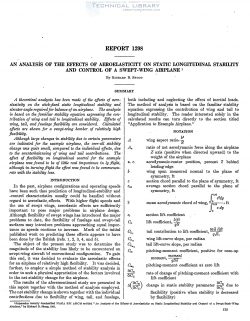naca-report-1298
- Version
- 193 Downloads
- 1.08 MB File Size
- 1 File Count
- November 2, 2016 Create Date
- November 2, 2016 Last Updated
National Advisory Committee for Aeronautics, Report - An Analysis of the Effects of Aeroelasticity on Static Longitudinal Stability and Control of a Swept Wing Airplane

A theoretical analysis has been made of the ejects of aero-
elasticity on the stick-fixed static longitudinal stability and
elevator angle required for balance of an airplane. The analysis
is based on the familiar stability equation expressing the con-
tribution of wing and tail to longitudinal stability. Ejects of
wing, tail, and fuselage flexibility are considered. Calculated
ejects are shown for a swept-wing bomberof relatively high
flexibility.
Although large changes in stability due to certain parameters
are indicated for the example airplane, the over-all stability
change was quite small, compared to the individual ejects, due
to the counterbalancing of wing and tail contributions. The
eject of flexibility on longitudinal control for the example
airplane was found to be of little real importance in lg flight,
although in turning flight the eject was found to be commensurate
with the stability loss.
In the past, airplane configurations and operating speeds
have been such that prediction of longitudinal-stability and
-control characteristics usually could be handled without
regard to aeroelastic, effects. With higher flight speeds and
the use of swept wings, aeroelastic effects are sufficiently
important to pose major problems in airplane design.
Although flexibility of swept wings has introduced the major
problems to date, the flexibility of fuselage and SWept-tail
surfaces may introduce problems approaching equal impor-
tance as speeds continue to increase. Much of the initial
published work on predicting these effects appears to have
been done by the British.
The object of the present study was to determine the
magnitude of the stability less likely to be encountered on
swept—wing aircraft ‘of conventional configuration. To gain
this end, it was decided to evaluate the aeroelastic efl’ects
for an airplane of relatively high flexibility. It was decided,
further, to employ a simple method of stability analysis in
order to seek a physical appreciation of the factors involved
in the net stability change for the airplane.
The results of the aforementioned study are presented in
this report together with the method of analysis employed.
The net stability change is shown together with the individual
contributions due to flexibility of wing, tail, and fuselage,
both including and neglecting the effect of inertial loads.
The method of analysis is based on the familiar stability
equation expressing the contribution of wing and tail to
longitudinal stability. The reader interested solely in the
calculated results can turn directly to the section titled
“Application to Example Airplane."
| File | Action |
|---|---|
| naca-report-1298 An Analysis of the Effects of Aeroelasticity on Static Longitudinal Stability and Control of a Swept Wing Airplane.pdf | Download |

Comment On This Post